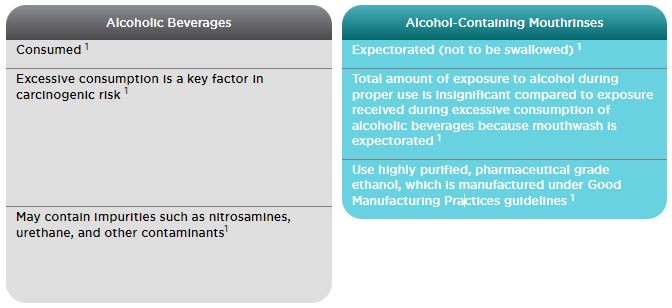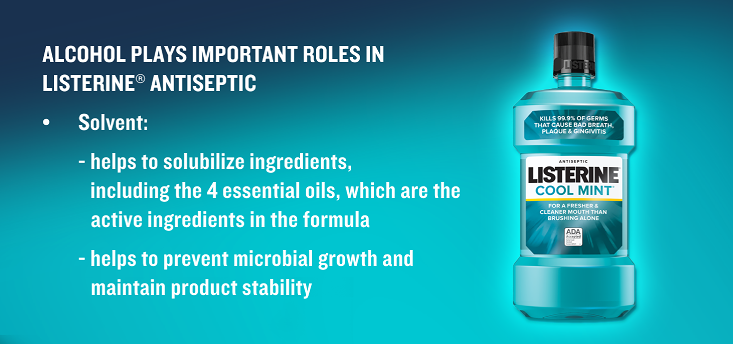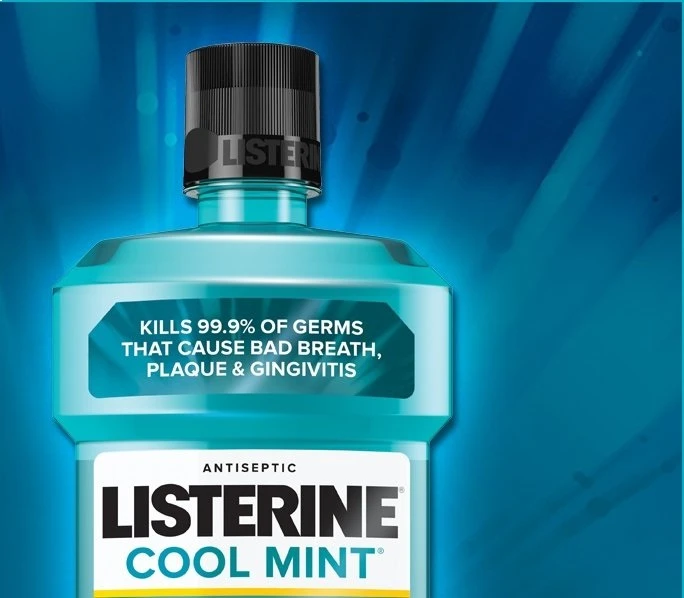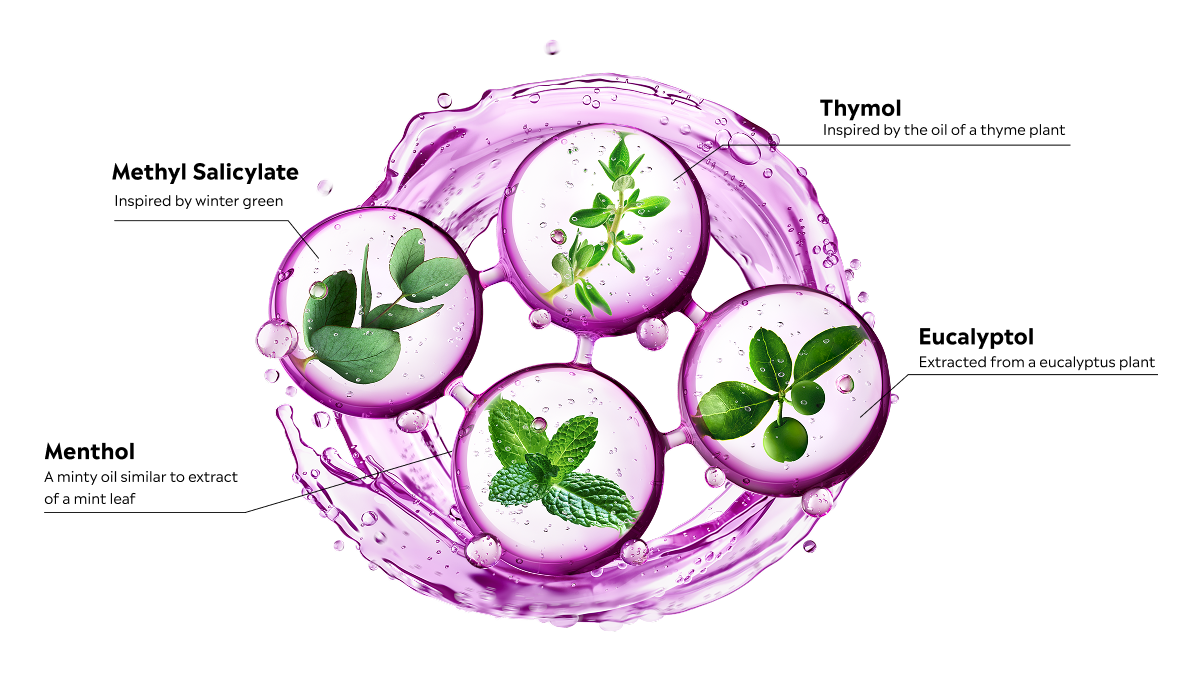WHEN IT COMES TO SAFETY, THERE ARE IMPORTANT DIFFERENCES BETWEEN ALCOHOLIC BEVERAGES AND ALCOHOL-CONTAINING MOUTHRINSES.


THE SAFETY OF ALCOHOL-CONTAINING MOUTHWASHES HAS BEEN DEMONSTRATED IN CLINICAL STUDIES FOR DECADES
LISTERINE® Antiseptic is the most extensively tested OTC mouthrinse in the world, with over 30 long-term clinical trials examining its safety and efficacy.1-10 Numerous studies over the past 40 years have shown that there is no negative impact detected in the use of mouthrinses containing alcohol.5-10
Clinical studies, meta-analyses, quantitative analyses, and systematic reviews of data have demonstrated that there is no causal link between the use of LISTERINE® Antiseptic mouthrinse and oral cancer or xerostomia.2-10


LISTERINE® ANTISEPTIC: DOES NOT PROMOTE ORAL DRYNESS
Clinical study findings
Favorable tolerability and no increase in dryness of oral tissue in patients with xerostomia (2 weeks of exaggerated use [3x daily] by subjects xerostomic as a result of Sjögren’s syndrome; Fischman SL et al. Am J Dent)2
No significant differences in salivary flow rates or patient-reported sensations of dry mouth between alcohol- and nonalcohol-containing mouthrinse groups (2-week randomized, crossover pilot studying the use of alcohol- and nonalcohol-containing mouthrinses in healthy adults; Kerr AR et al. Quintessence Int)3
Alcohol-based essential oil mouthrinse no more likely to cause a reduction in salivary flow or perceived dryness than a non-alcohol-based cetylpyridinium chloride (CPC) mouthrinse. (Kerr AR, et al. Oral Surg Oral Med Oral Pathol Oral Radiol Endod)4
LISTERINE® ANTISEPTIC: NO CREDIBLE LINK TO ORAL CANCER
Clinical study findings
“There is no sufficient evidence to accept the proposition that the use of mouthwashes containing alcohol can influence the development of oral cancer” (Systematic review of 14 articles—11 case-control studies and 3 clinical trials—on mouthwash use and risk of oral cancer; Aceves Argemí R et al. J Evid BasedDent Pract)5
No significant association with mouthwash and risk of oral cancer (Meta-analysis of 12 epidemiologic studies on mouthwash and risk of oral cancer; International Agency for Research on Cancer [IARC])6
“Data do not support a causal relationship between use of alcohol-containing mouthrinses and oral cancer” (FDA subcommittee reviewed 7 case-control studies; US Food and Drug Administration)7
Alcohol-containing mouthwash does not increase risk of oropharyngeal cancer (Review of 9 case-control studies; Cole P et al. J Am Dent Assoc)8
Link between mouthwash use and oral cancers not supported by epidemiological evidence (Critical review of published data; La Vecchia et al. Oral Oncology)9
No association between mouthwash use and oral malignancy (Quantitative analysis of all published epidemiological studies of mouthwash use and oral malignancy; Boyle et al. Oral Surg Oral Med Oral Pathol Oral Radiol Endod)10
“Alcohol-containing mouthrinses pose little threat to systemic human exposure to alcohol itself or products of its metabolism [acetaldehyde] if used as directed.” 10
Boyle et al. Oral Dis. 2014;20(suppl 1):1-68
Acetaldehyde is a naturally occurring substance; it is found in the human body as well as in fruits and vegetables, and is a metabolite produced when ethanol is ingested 10
Acetaldehyde associated with consumption of alcoholic beverages is carcinogenic at high levels 6
The peak acetaldehyde level found for LISTERINE® Antiseptic is 44.3 μmol at 30s, a concentration that is more than 1000 times lower than the levels required to damage DNA in cultured buccal epithelial cells 11

LISTERINE ® ANTISEPTIC HAS EARNED
THE ADA SEAL OF ACCEPTANCE

LISTERINE® Antiseptic met specific guidelines for Chemotherapeutic Products for Control of Gingivitis category, including carcinogenicity and mutagenicity studies to assess possible adverse effects at the cellular level. 12*



*Contact the ADA for more information on the ADA Seal and to obtain Seal guidelines.
References:
1. Data on file, Johnson & Johnson Consumer Inc.
2. Fischman SL, Aguirre A, Charles CH. Use of essential oil—containing mouthrinses by xerostomic individuals: determination of potential for oral mucosal irritation. Am J Dent. 2004;17(1):23-26.
3. Kerr AR, Katz RW, Ship JA. A comparison of the effects of 2 commercially available nonprescription mouthrinses on salivary flow rates and xerostomia. Quintessence Int. 2007;38(8):e440-e447.
4. Kerr AR, Corby PM, Kalliontzi K, McGuire JA, Charles CA. Comparison of two mouthrinses in relation to salivary flow and perceived dryness. Oral Surg Oral Med Oral Pathol Oral Radiol. 2015;119(1):59-64.
5. Aceves Argemí R, González Navarro B, Ochoa García-Seisdedos P, Estrugo Devesa A, López-López J. Mouthwash with alcohol and oral carcinogenesis: systematic review and meta-analysis. J Evid Based Dent Pract. 2020;20(2):101407.
6. International Agency for Research on Cancer (IARC). IARC monographs on the evaluation of carcinogenic risks to humans: Report of the advisory group to recommend priorities for IARC Monographs during 2015-2019. https://monographs.iarc.fr/wp-content/uploads/2018/08/14-002.pdf. Accessed November 1, 2021.
7. Food and Drug Administration. Oral health care drug products for over-the-counter human use; antigingivitis/antiplaque drug products; establishment of a monograph; proposed rules. Part Ill. Fed Regist. 2003;68(103):32232-32287.
8. Cole P, Rodu B, Mathisen A. Alcohol-containing mouthwash and oropharyngeal cancer: a review of the epidemiology. J Am Dent Assoc. 2003;134(8):1079-1087.
9. La Vecchia C. Mouthwash and oral cancer risk: an update. Oral Oncol. 2009;45(3):198-200.
10. Boyle P, Gandini S, Boffetta P, Negri E, La Vecchia C. Mouthwash use and oral cancer risk: quantitative meta-analysis of epidemiologic studies. Oral Surg Oral Med Oral Pathol Oral Radiol Endod. 2011;112(6):e130.
11. Vaca CE, Nilsson JA, Fang JL, Grafström RC. Formation of DNA adducts in human buccal epithelial cells exposed to acetaldehyde and methylglyoxal in vitro. Chem Biol Interact. 1998;108:197–208.
12. American Dental Association. ADA seal product report: Listerine® Cool Mint® Antiseptic. ADA Website.https://www.ada.org/resources/research/science-and-research-institute/ad....
Accessed November 1, 2021.

